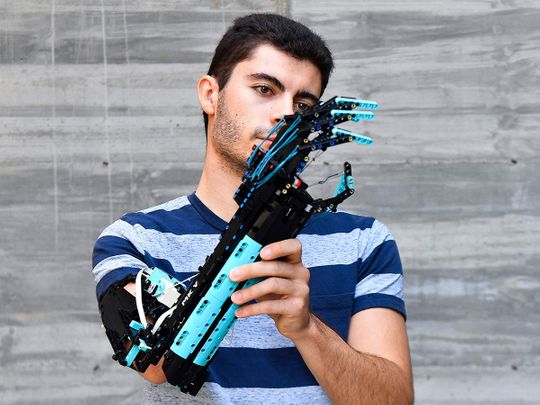
Barcelona: David Aguilar was five when he first discovered Lego, entering a world where it didn't matter he was missing his forearm, and four years later, he built his first prosthesis with it.
Now on the verge of finishing a degree in bioengineering, he dreams of working to help other children who, like him, were born different.
Aguilar was born without a right forearm as a result of Poland syndrome, a rare disorder which can cause severe abnormalities in the shoulder, arm or hand, but it has not stopped him from living his life.
Now 22, this Andorran student - who has been obsessed with robots since he was a child - has little free time: aside from finishing his degree, he gives motivational speeches, has written a book and taken part in an innovation conference run by NASA.
But getting here hasn't been easy and his face hardens as he recalls the years when building things with Lego was his only refuge from bullying.
"When I was a teenager, I carried on playing with Lego because it was a way of escaping the bullying, it really helped me ignore all the jibes I had to put up with every day," he told AFP at his university residence near Barcelona.
During his teens, he set up a YouTube channel calling himself "Hand Solo", a play on the name of smuggler-pilot hero Han Solo from the early "Star Wars" films.
Over the years, he fine-tuned his construction skills and by the age of 17, he had managed to create a fully-functioning Lego prosthetic that allowed him to do his first-ever pushups with two arms.
Since then, he has further refined his technique, proudly showing off his latest version, the MK5, which has a much more sleek robotic look and long pale-blue "fingers" which are activated by muscles operating a motorised pulley.
Long accustomed to life without his forearm, Aguilar doesn't use a prosthesis every day but he knows that many people do, and that it can cost many thousands of euros for the newest models.
"Since I made that first prosthesis, I realised that I had the power to help other people. And when I looked in the mirror and saw myself with two arms, I thought that other people really might need that too," he said.
Arming an 8-year-old
After he was awarded the Guinness World Record for creating the first functional Lego prosthetic arm in 2017, news about Hand Solo's wizardry quickly spread.
Finding his story online earlier this year, Zaure Bektemissova decided to write him an email from her home in northeastern France.
Her son Beknur, she wrote, was eight-years-old and had no arms. The doctors couldn't make him a normal prosthesis and she was looking for help.
"Prosthetics are mostly standard, they are big and heavy, so for his spine it was not a good idea," she told AFP at her home in Strasbourg where the family has lived for two years since her husband took up a diplomatic post at the Kazakhstan consulate.
Aguilar promised to try and at the end of August, Bektemissova and her son drove 1,300 kilometres (800 miles) to Andorra, a tiny principality in the Pyrenees mountains, sandwiched between Spain and France, to meet him and try out the new prosthesis he'd made.
Made entirely of Lego, the lightweight device has a pincer-like grabble at the end which Beknur can control with a cord manipulated by his left foot.
"Now I can grab things with my hand, before I couldn't," beams Beknur, throwing a ball to his brother.
Having that extra bit of independence has really helped, his mum says.
"He can do a lot of things with it so his self-esteem is high now, compared to what was before," she smiles.
And the experience has inspired Aguilar.
"If I did it for Beknur, why not for any other boy or girl who's missing an arm or a leg or a foot?" he says, his eyes alight with ideas.








